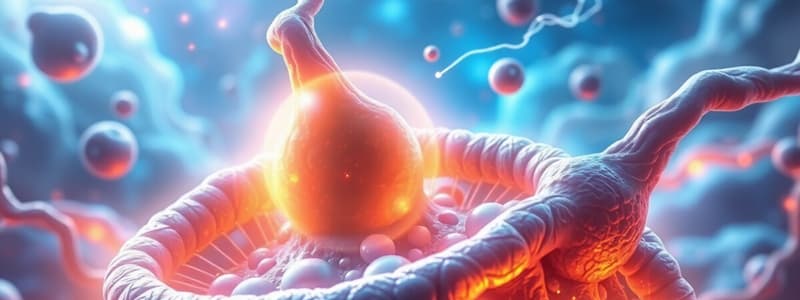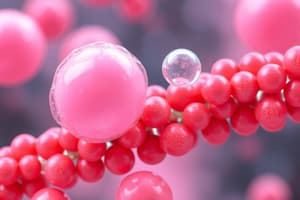Podcast
Questions and Answers
What happens to the movement of water in an isotonic solution?
What happens to the movement of water in an isotonic solution?
- There is no net movement of water. (correct)
- Water moves equally into and out of the cell.
- Water moves into the cell only.
- Water moves out of the cell only.
Which of the following describes hypotonic solutions?
Which of the following describes hypotonic solutions?
- Solute concentration inside the cell is higher than outside. (correct)
- Cells do not experience swelling in hypotonic solutions.
- Net movement of water is towards the outside of the cell.
- Water concentration is higher outside than inside the cell. (correct)
What distinguishes cuboidal epithelial cells?
What distinguishes cuboidal epithelial cells?
- They are specifically designed for diffusion.
- They are flat and allow filtration.
- They may have microvilli on their apical surface. (correct)
- They are tall and thin with cilia.
What characteristic is unique to transitional epithelial cells?
What characteristic is unique to transitional epithelial cells?
Which epithelium type is mainly associated with absorption and secretion?
Which epithelium type is mainly associated with absorption and secretion?
Which statement correctly describes the synthesis of molecules in cells?
Which statement correctly describes the synthesis of molecules in cells?
What role do cell membranes play in communication within the body?
What role do cell membranes play in communication within the body?
What is the primary function of the lipid bilayer in cell membranes?
What is the primary function of the lipid bilayer in cell membranes?
How do muscle cells respond to signals from nerve cells?
How do muscle cells respond to signals from nerve cells?
What characteristic of phospholipids allows them to form a bilayer in cell membranes?
What characteristic of phospholipids allows them to form a bilayer in cell membranes?
Which type of cell is primarily responsible for transmitting genetic information to the next generation?
Which type of cell is primarily responsible for transmitting genetic information to the next generation?
What is involved in the role of energy production in muscle cells?
What is involved in the role of energy production in muscle cells?
What type of information do cells produce and receive for communication?
What type of information do cells produce and receive for communication?
What are the primary functions of peroxisomes in cells?
What are the primary functions of peroxisomes in cells?
Which statement about mitochondria is true?
Which statement about mitochondria is true?
What structure within mitochondria is primarily involved in the production of ATP?
What structure within mitochondria is primarily involved in the production of ATP?
Which protein elements make up the cytoskeleton?
Which protein elements make up the cytoskeleton?
How does the mitochondrion contribute to intracellular ion regulation?
How does the mitochondrion contribute to intracellular ion regulation?
What is the main energy currency produced by mitochondria?
What is the main energy currency produced by mitochondria?
What role do microfilaments play in a cell?
What role do microfilaments play in a cell?
What harmful by-product is generated during the breakdown of fatty acids?
What harmful by-product is generated during the breakdown of fatty acids?
What is the primary function of adipose tissue?
What is the primary function of adipose tissue?
What do adherens junctions primarily form?
What do adherens junctions primarily form?
Which type of junction binds to intermediate filaments?
Which type of junction binds to intermediate filaments?
How do endocrine glands secrete their substances?
How do endocrine glands secrete their substances?
What is the composition of the epidermis?
What is the composition of the epidermis?
Which type of gland secretes substances through ducts?
Which type of gland secretes substances through ducts?
What connects adjacent cells in gap junctions?
What connects adjacent cells in gap junctions?
Which structure is NOT part of the integumentary system?
Which structure is NOT part of the integumentary system?
What is the primary purpose of cell division in the body?
What is the primary purpose of cell division in the body?
Which phase of mitosis involves chromosomes aligning at the cell's center?
Which phase of mitosis involves chromosomes aligning at the cell's center?
What is the main difference between mitosis and meiosis?
What is the main difference between mitosis and meiosis?
How does osmosis primarily function in relation to cell membranes?
How does osmosis primarily function in relation to cell membranes?
What occurs during anaphase in mitosis?
What occurs during anaphase in mitosis?
What happens during telophase of mitosis?
What happens during telophase of mitosis?
Which statement best describes the similarity between mitosis and meiosis?
Which statement best describes the similarity between mitosis and meiosis?
In the context of osmosis, what does a selectively permeable membrane do?
In the context of osmosis, what does a selectively permeable membrane do?
Flashcards are hidden until you start studying
Study Notes
Cell Functions and Structures
- Technology allows identification of disorders linked to cellular functions.
- Cellular metabolism boosts energy for muscle contraction and heat production.
- Cells synthesize proteins, nucleic acids, and lipids, determining their structural and functional characteristics.
- Communication occurs via chemical and electrical signals, with cell membranes acting as gatekeepers.
- The lipid bilayer of the cell membrane separates internal and external environments and consists of hydrophilic phosphate ends and hydrophobic fatty acid ends.
Cell Organelles
- Mitochondria are the primary ATP (Adenosine Triphosphate) producers, crucial for energy in biochemical reactions.
- Mitochondria regulate intracellular calcium and are structured with a smooth outer membrane and a folded inner membrane (cristae).
- Peroxisomes break down fatty acids and detoxify hydrogen peroxide, significant for liver and kidney cells.
- Lysosomes digest phagocytized materials using enzymes.
Cytoskeleton
- The cytoskeleton supports organelles and facilitates shape changes within the cell.
- It comprises microfilaments (providing mechanical support), intermediate filaments, and microtubules.
Cell Division
- Osmosis is the diffusion of water across a selectively permeable membrane, helping to equalize concentration gradients.
- Mitosis consists of four stages:
- Prophase: Chromosomes condense, with chromatids joined at centromeres.
- Metaphase: Aligns chromosomes at the cell center.
- Anaphase: Chromatids separate and move to opposite poles.
- Telophase: New nuclei form, completing division into two daughter cells.
Meiosis
- Meiosis is similar to mitosis but involves two rounds of division, essential for sexual reproduction.
Concentration States
- Isotonic solutions maintain equal solute concentrations inside and outside cells, resulting in no net water movement.
- Hypotonic solutions have lower external solute concentrations, causing cells to swell.
Epithelial Tissue Types
- Squamous: Flat cells allowing diffusion and filtration.
- Cuboidal: Cube-shaped cells aiding secretion and absorption, often with microvilli.
- Columnar: Tall cells, sometimes with microvilli or cilia for secretion and absorption.
- Transitional: Cells that change shape, found in stretchable organs like the urinary bladder.
Tissue Types and Junctions
- Muscular tissue generates force for body movement.
- Nervous tissue detects changes and transmits nerve impulses.
- Adherens junctions anchor cells with a plaque structure for force coordination.
- Desmosomes bind cells but do not form belts and connect to intermediate filaments.
- Hemidesmosomes attach cells to the basement membrane without linking adjacent cells.
- Gap junctions create channels for ion and molecule transfer.
Glands
- Glands consist of glandular epithelial cells and secrete substances.
- Endocrine glands are ductless, releasing hormones directly into the blood.
- Exocrine glands have ducts, secreting substances like sweat or saliva directly onto surfaces.
Integumentary System
- The integumentary system includes skin, hair, glands, nails, and sensory receptors, serving protective and regulatory functions.
Studying That Suits You
Use AI to generate personalized quizzes and flashcards to suit your learning preferences.




